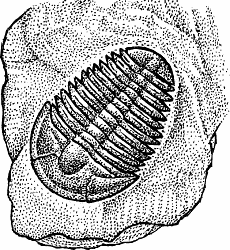Illustration of trilobite

- trilobite fossil

 Nina Turner, Newsweek, 29 Oct. 2024
The exhibition achieves that goal with a thoughtful and heady combination of nearly 200 scientific and literary publications; artworks; and loans, including ammonites, trilobites and a cast of an ichthyosaurus skull.
—
Nina Turner, Newsweek, 29 Oct. 2024
The exhibition achieves that goal with a thoughtful and heady combination of nearly 200 scientific and literary publications; artworks; and loans, including ammonites, trilobites and a cast of an ichthyosaurus skull.
— Anne Wallentine, Smithsonian Magazine, 8 Oct. 2024
The resultant habitat loss and cooling temperatures caused the extinction of approximately 85% of marine species, including many brachiopods and trilobites.
—
Anne Wallentine, Smithsonian Magazine, 8 Oct. 2024
The resultant habitat loss and cooling temperatures caused the extinction of approximately 85% of marine species, including many brachiopods and trilobites.
— Scott Travers, Forbes, 7 Sep. 2024
Early life had been thriving in a warm greenhouse world, as creatures such as trilobites, corals, brachiopods and more evolved to fill in the coastal shallows.
—
Scott Travers, Forbes, 7 Sep. 2024
Early life had been thriving in a warm greenhouse world, as creatures such as trilobites, corals, brachiopods and more evolved to fill in the coastal shallows.
— Riley Black, Smithsonian Magazine, 12 July 2024
See all Example Sentences for trilobite
Riley Black, Smithsonian Magazine, 12 July 2024
See all Example Sentences for trilobite 

borrowed from German Trilobit, from New Latin trilobus "three-lobed" (borrowed from Greek trílobos, from tri- tri- + -lobos, adjective derivative of lobós lobe) + German -it -ite entry 1
Note: German Trilobit was introduced by the theologian and naturalist Johann Ernst Immanuel Walch (1725-78) in Die Naturgeschichte der Versteinerungen zur Erläuterung der Knorrischen Sammlung von Merkwürdigkeiten der Natur ("The Natural History of Fossils, as a Commentary on the Knorr Collection of the Curiosities of Nature"), 3. Theil (Nuremberg, 1771) p. 120 and following. This work, in four parts issued from 1768 to 1773, was an expanded and greatly improved edition of a publication begun by the Nuremberg engraver and fossil collector Georg Wolfgang Knorr, who had died in 1761. According to Walch, "Da man dieses Petrefact Anfangs nur Stückweise entdeckte, und nicht wusste, zu was vor einer Gattung von Körpern man dasselbe rechnen sollte, so hielte sich fast jeder Naturforscher, der dasselbe bekannt machte, für berechtiget, ihm einen eigenen Nahmen beyzulegen …[there follows a discussion of various names, as concha trílobos [latter word in Greek letters], concha triloba rugosa, pectunculites trilobus, entomolithus paradoxus, Dudley fossil, etc.]…Alle aber, zusammen genommen, sind ihm gegeben worden, entweder von seiner Gestalt und Aenlichkeit, die es mit andern Körpern hat, oder von dem vermeintlichen Original, so man, wiewohl meist ohne Grund, dafür angesehen, oder von dem Ort und Gegend, wo man dasselbe gefunden. Wir wollen ihm die allersimpelste Benennung beylegen, und es einen Trilobiten nennen" ("Since early on only fragments of the fossil had been discovered, and no one knew the category of body under which it should be considered, almost every investigator of nature who made it known felt justified in conferring on it his own name …Taken together, all these names have been given either from its shape and similarity to other bodies, or from what is regarded, usually without any basis, as the presumed prototype, or from the place where it was found. We want to confer on it the simplest name possible, and call it a trilobite"). (Walch uses Trilobit as a weak noun, with an accusative singular Trilobiten.) Walch's Naturgeschichte der Versteinerungen was translated into Dutch (3rd Part, 1773) and French (3rd Part, 1775), with the animal designated respectively as Trilobiet and Trilobite in these languages. Further details about Walch, as well as an English translation of the French version of relevant passages from Naturgeschichte der Versteinerungen, can be found in Robert Kihm and James St. John, "Walch's Trilobite Research—A Translation of His 1771 Trilobite Chapter," Fabulous Fossils—300 Years of Worldwide Research on Trilobites, edited by D.G. Mikulic, et al., New York State Museum Bulletin 507 (Albany, 2007), pp. 115-40. Note that Walch only uses Trilobit as a vernacular designation; the class name Trilobita, though attributed to Walch in taxonomic literature, does not appear in the book.
1832, in the meaning defined above
“Trilobite.” Merriam-Webster.com Dictionary, Merriam-Webster, https://www.merriam-webster.com/dictionary/trilobite. Accessed 28 Nov. 2024.
trilobite
noun
Britannica.com: Encyclopedia article about trilobite


Share